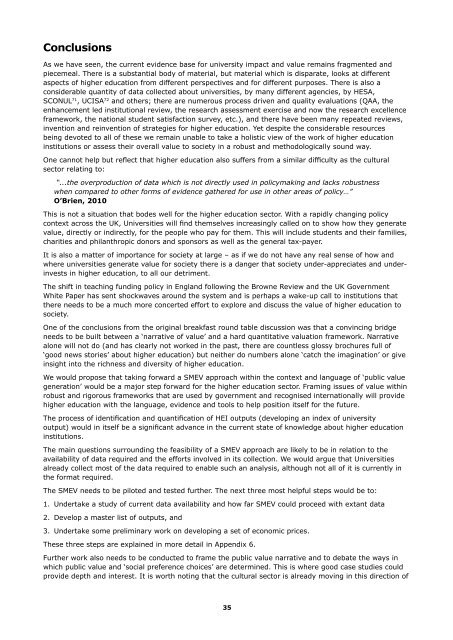Through a glass darkly Measuring the social value of universities
80096 NCCPE Social Value Report (2)
80096 NCCPE Social Value Report (2)
- No tags were found...
You also want an ePaper? Increase the reach of your titles
YUMPU automatically turns print PDFs into web optimized ePapers that Google loves.
ConclusionsAs we have seen, <strong>the</strong> current evidence base for university impact and <strong>value</strong> remains fragmented andpiecemeal. There is a substantial body <strong>of</strong> material, but material which is disparate, looks at differentaspects <strong>of</strong> higher education from different perspectives and for different purposes. There is also aconsiderable quantity <strong>of</strong> data collected about <strong>universities</strong>, by many different agencies, by HESA,SCONUL 71 , UCISA 72 and o<strong>the</strong>rs; <strong>the</strong>re are numerous process driven and quality evaluations (QAA, <strong>the</strong>enhancement led institutional review, <strong>the</strong> research assessment exercise and now <strong>the</strong> research excellenceframework, <strong>the</strong> national student satisfaction survey, etc.), and <strong>the</strong>re have been many repeated reviews,invention and reinvention <strong>of</strong> strategies for higher education. Yet despite <strong>the</strong> considerable resourcesbeing devoted to all <strong>of</strong> <strong>the</strong>se we remain unable to take a holistic view <strong>of</strong> <strong>the</strong> work <strong>of</strong> higher educationinstitutions or assess <strong>the</strong>ir overall <strong>value</strong> to society in a robust and methodologically sound way.One cannot help but reflect that higher education also suffers from a similar difficulty as <strong>the</strong> culturalsector relating to:“...<strong>the</strong> overproduction <strong>of</strong> data which is not directly used in policymaking and lacks robustnesswhen compared to o<strong>the</strong>r forms <strong>of</strong> evidence ga<strong>the</strong>red for use in o<strong>the</strong>r areas <strong>of</strong> policy…”O’Brien, 2010This is not a situation that bodes well for <strong>the</strong> higher education sector. With a rapidly changing policycontext across <strong>the</strong> UK, Universities will find <strong>the</strong>mselves increasingly called on to show how <strong>the</strong>y generate<strong>value</strong>, directly or indirectly, for <strong>the</strong> people who pay for <strong>the</strong>m. This will include students and <strong>the</strong>ir families,charities and philanthropic donors and sponsors as well as <strong>the</strong> general tax-payer.It is also a matter <strong>of</strong> importance for society at large – as if we do not have any real sense <strong>of</strong> how andwhere <strong>universities</strong> generate <strong>value</strong> for society <strong>the</strong>re is a danger that society under-appreciates and underinvestsin higher education, to all our detriment.The shift in teaching funding policy in England following <strong>the</strong> Browne Review and <strong>the</strong> UK GovernmentWhite Paper has sent shockwaves around <strong>the</strong> system and is perhaps a wake-up call to institutions that<strong>the</strong>re needs to be a much more concerted effort to explore and discuss <strong>the</strong> <strong>value</strong> <strong>of</strong> higher education tosociety.One <strong>of</strong> <strong>the</strong> conclusions from <strong>the</strong> original breakfast round table discussion was that a convincing bridgeneeds to be built between a ‘narrative <strong>of</strong> <strong>value</strong>’ and a hard quantitative valuation framework. Narrativealone will not do (and has clearly not worked in <strong>the</strong> past, <strong>the</strong>re are countless glossy brochures full <strong>of</strong>‘good news stories’ about higher education) but nei<strong>the</strong>r do numbers alone ‘catch <strong>the</strong> imagination’ or giveinsight into <strong>the</strong> richness and diversity <strong>of</strong> higher education.We would propose that taking forward a SMEV approach within <strong>the</strong> context and language <strong>of</strong> ‘public <strong>value</strong>generation’ would be a major step forward for <strong>the</strong> higher education sector. Framing issues <strong>of</strong> <strong>value</strong> withinrobust and rigorous frameworks that are used by government and recognised internationally will providehigher education with <strong>the</strong> language, evidence and tools to help position itself for <strong>the</strong> future.The process <strong>of</strong> identification and quantification <strong>of</strong> HEI outputs (developing an index <strong>of</strong> universityoutput) would in itself be a significant advance in <strong>the</strong> current state <strong>of</strong> knowledge about higher educationinstitutions.The main questions surrounding <strong>the</strong> feasibility <strong>of</strong> a SMEV approach are likely to be in relation to <strong>the</strong>availability <strong>of</strong> data required and <strong>the</strong> efforts involved in its collection. We would argue that Universitiesalready collect most <strong>of</strong> <strong>the</strong> data required to enable such an analysis, although not all <strong>of</strong> it is currently in<strong>the</strong> format required.The SMEV needs to be piloted and tested fur<strong>the</strong>r. The next three most helpful steps would be to:1. Undertake a study <strong>of</strong> current data availability and how far SMEV could proceed with extant data2. Develop a master list <strong>of</strong> outputs, and3. Undertake some preliminary work on developing a set <strong>of</strong> economic prices.These three steps are explained in more detail in Appendix 6.Fur<strong>the</strong>r work also needs to be conducted to frame <strong>the</strong> public <strong>value</strong> narrative and to debate <strong>the</strong> ways inwhich public <strong>value</strong> and ‘<strong>social</strong> preference choices’ are determined. This is where good case studies couldprovide depth and interest. It is worth noting that <strong>the</strong> cultural sector is already moving in this direction <strong>of</strong>35


